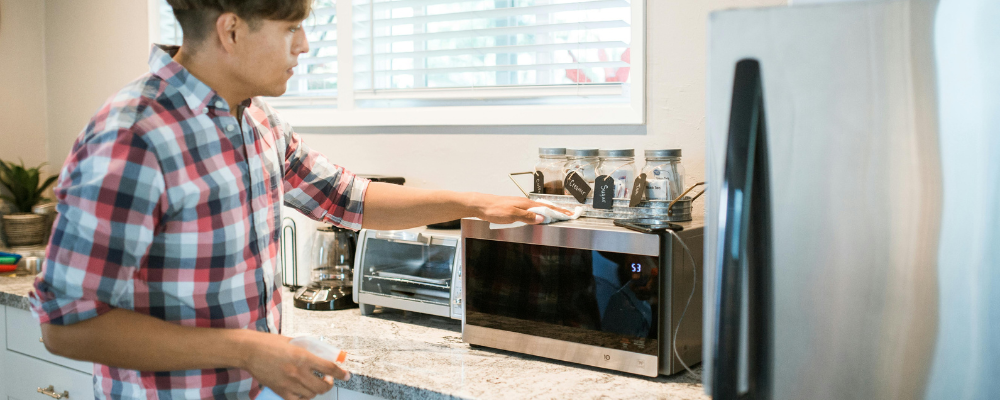
Kitchen Cleaning Made Easy: Tips for a Healthier Home
— By Alex Bosse, Nutrition Education Professional for UMaine Cooperative Extension EFNEP (Expanded Food & Nutrition Education Program).
A clean kitchen isn’t just nice to look at, it helps keep you and your family safe from foodborne illness. Germs can live on countertops, cutting boards, utensils, handles, sponges, appliances, and other food contact surfaces. Regularly cleaning and sanitizing your kitchen can help stop the spread of harmful germs. Here’s what you need to know to keep your kitchen clean and safe.
Cleaning vs. Sanitizing: What’s the Difference?
Cleaning removes dirt, dust, food, and debris from surfaces. You can clean surfaces effectively with soap and water.
Sanitizing reduces the number of germs on surfaces to levels considered safe. To sanitize, you can use commercial sanitizers or common household items like diluted bleach, hydrogen peroxide, or white vinegar.
To keep your kitchen safe, it’s important to first clean, and then sanitize.
Cleaning
Before you start cleaning, wash your hands with soap and warm water for at least 20 seconds. Handwashing is one of the best ways to stop the spread of germs.
Clean kitchen food contact surfaces often, especially before and after preparing food. This helps prevent cross-contamination, which is when germs are transferred from one object to another.
To clean:
- Use hot, soapy water to wash countertops, cutting boards, utensils, dishes,and other food contact surfaces.
- Rinse well with clean water.
Sanitizing
After cleaning, the next step is to sanitize. You can buy commercial sanitizers at the store, or you can make your own using common household products. Here are a few easy homemade options.
Bleach Solution
- Mix 1 teaspoon of unscented bleach with 1 quart (4 cups) of cool water (hot water can weaken bleach).
- Pour solution into a labeled spray bottle.
- Spray on clean surfaces and let sit for at least 1 minute.
- Let air dry.
* Important: Food and dirt can make bleach less effective, so always clean surfaces first and replace your bleach solution every week and store in a dark location.
Hydrogen Peroxide or White-Distilled Vinegar
Option 1 (Warming Solution)
- Heat 4 oz. (1/2 cup) of white distilled vinegar or hydrogen peroxide to about 150°F (hot, but not boiling).
- Pour into a labeled spray bottle.
- Spray on clean surfaces and let sit for at least 1 minute.
- Wipe with a paper towel or let air dry.
Option 2 (Room Temperature Solution)
- Pour 4 oz. (1/2 cup) of white vinegar or hydrogen peroxide at room temperature into a labeled spray bottle.
- Spray on clean surfaces and let sit for at least 10 minutes.
- Wipe with a paper towel or let air dry.
Always label your homemade sanitizing bottles clearly so you know what’s inside. Keep all cleaning and sanitizing solutions out of reach of children to prevent accidents. Never mix vinegar with hydrogen peroxide, as this can create harmful fumes, and to protect your skin, wear rubber gloves when using these solutions, since they can sometimes cause irritation.
Kitchen Cleaning & Sanitation Guide
How often you clean and sanitize your kitchen depends on your situation. For example, if you live with young children, older adults, someone who is sick or has a compromised immune system, or if you have pets, you may need to clean more often. The chart below gives basic guidelines for how and when to clean and sanitize different parts of your kitchen.
| Item/Surface | How Often to Clean and Sanitize |
| Sinks |
|
| Sponges |
|
| Potholders, dishcloths, and towels |
|
| Refrigerator and Freezer |
|
| Microwave |
|
| Oven |
|
Keeping your kitchen clean and sanitized doesn’t have to be complicated. By following a regular routine and using simple household items, you can help protect yourself and your family from harmful germs. Whether you’re wiping down counters, cleaning out the fridge, or swapping out dish towels, every small step adds up to a safer, healthier kitchen. A clean kitchen isn’t just a good habit, it’s an important part of food safety.
Resources
- Cleaning & Sanitizing the Kitchen: Using inexpensive household food-safe products (Colorado State Cooperative Extension)
- Clean THEN Sanitize: A One-Two Punch to Stop Foodborne Illness in the Kitchen (USDA)
- When and How to Clean and Disinfect Your Home (CDC)
- A Clean Kitchen is Required for Food Safety (University of Minnesota Cooperative Extension)
- Microwave Cooking and Safety (South Dakota State Cooperative Extension)
- Cleaning Your Oven for Holiday Roasting and Baking (Cornell Cooperative Extension)
